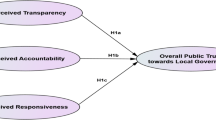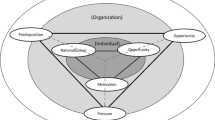Abstract
The great interest in biobanks, the related, substantial investments, and the expectations connected with them raises the question of how to explain the relative successes and failures of contemporary biobank projects. In this article we will present and discuss areas that need ongoing attention by many stakeholders in order stabilize and utilize biobanks and biobank networks in the future. Our aim is to present and utilize an analytical model for comparing structures of biobank governance. The governance model we deduce from empirical case studies is not a well-ordered, almost bureaucratic type of government. The patchwork character and the interrelatedness of heterogeneous activities that constitute biobank governance in its multiple dimensions will be highlighted. Biobank governance should therefore be understood as strategy for patterning a network of interaction that unfolds within and across a number of different fields including a variety of activities that go beyond regulatory activities: the scientific/technological field, the medical/health field, the industrial–economic field, the legal–ethical, and the sociopolitical field. Our account emphasizes that biobanks are not technical visions that operate vis-à-vis an external society. The article discusses attempts to develop participatory governance structures. It concludes that facilitating and managing the integration of a network of more or less interrelated actors, in many nonhierarchic ways, should not be equated with democratization per se, but can nevertheless be regarded as an important step towards a more pluralistic and inclusive style of policy making.

Similar content being viewed by others
Notes
The entrepreneurial biobank model does, however, obviously still exist. One example is the German company Indivumed, which as of this writing seems to remain successful. See www.indivumed.com.
The UK Biobank is jointly funded by the public health care system (National Health Service) and by a research charity (the Wellcome Trust), neither of which are oriented towards private commercialization.
This could for example happen in the wake of scandals in which biobank staff would pass on samples and information for unintended purposes.
References
Bäckstrand K (2008) Accountability of networked climate governance: the rise of transnational climate partnerships. Glob Environ Polit 8(3):74–102
Barry A (2001) Political machines. Governing a technological society. Athlone Press, London, p 53
UK Biobank (2003) Summary of the UK Biobank Consultation on the Ethics and Governance Framework
Björkman B, Hansson SO (2006) Bodily rights and property rights. J Med Ethics 32:209–214
Brown N, Webster A (2004) New medical technologies and society. Polity, Cambridge
Callon M (2005) Disabled persons of all countries, unite! In: Latour B, Weibel P (eds) Making things public: atmospheres of democracy. MIT Press, Cambridge, pp 308–313
Cambon-Thomsen A (2003) Assessing the impact of biobanks. Nat Genet 34(5):25–26
Cambon-Thomsen A, Ducournau P, Gourraud P-A, Pontille D (2003) Biobanks for genomics and genomics for biobanks. Comp Funct Genomics 4:628–634
Cambon-Thomsen A, Rial-Sebbag E, Knoppers BM (2007) Trends in ethical and legal frameworks for the use of human biobanks. Eur Respir J 30:373–382
Check Hayden E (2009) Icelandic genomics firm goes bankrupt. Nature 462:401
Corrigan O, Petersen A (2008) UK Biobank: bioethics as a technology of governance. In: Gottweis H, Petersen A (eds) Biobanks: comparative governance. Routledge, London, pp 143–158
Cutter M, Wilson S, Chadwick R (2004) Balancing powers: examining models of biobank governance. J Int Biotechnol Law 1(5):187–192
Dewey J (1991) The public and its problems. Ohio University Press, Athens
Dingwerth K, Pattberg P (2009) World politics and organizational fields: the case of transnational sustainability governance. Eur J Int Relat 15(4):707–744
Eensaar R (2008) Estonia. Ups and downs of a Biobank Project. In: Gottweis H, Petersen A (eds) Biobanks. Governance in comparative perspective. Routledge, London, pp 41–55
Eiseman E, Bloom G, Brower J, Clancy N, Olmsted S (2003) Human tissue repositories. Best practice for the genomic and proteomic era. RAND Corporation, Santa Monica
Elger BS, Caplan AL (2006) Consent and anonymization in research involving biobanks: differing terms and norms present serious barriers to an international framework. EMBO Rep 7(7):661–666
Everett M (2003) The social life of genes: privacy, property and the new genetics. Soc Sci Med 56(1):53–65
Everett M (2004) Can you keep a genetic secret? The genetic privacy movement. J Genet Couns 13(4):273–291
Fortun M (2008) Promising genomics: Iceland and deCODE genetics in a world of speculation. University of California Press, Berkeley
Gottweis H, Lauss G (2010) Biobank governance in the post-genomic age. Pers Med 7(2):187–195
Gottweis H, Petersen A (2008) Biobanks: governance in comparative perspective. Routledge, London
Gottweis H, Braun K, Haila Y, Hajer M, Loeber A, Metzler I, Reynolds L, Schultz S, Szerszynski B (2008) Participation and the new governance of life. BioSocieties 3:265–286
Hagen H-E, Carlstedt-Duke J (2004) Building global networks for human diseases: genes and populations. Nat Med 10(7):665–667
Hajer MA, Wagenaar H (2003) Deliberative policy analysis: understanding governance in the network society. Cambridge University Press, Cambridge
Hansson MG, Dillner J, Bartram CR, Carlson JA, Helgesson G (2006) Should donors be allowed to give broad consent to future biobank research? Lancet Oncol 7(3):266–269
Held D, McGrew A, Goldblatt D, Perraton J (1999) Global transformations: politics economics and culture. Polity Press, Cambridge
Hirtzlin I, Dubreuil C, Preaubert N, Duchier J, Jansen B, Simon J, Lobato de Faria P, Perez-Lezaun A, Visser B, Williams GD, Cambon-Thomsen A (2003) An empirical survey on biobanking of human genetic material and data in six EU countries. Eur J Hum Genet 11(6):475–488
Hoeyer K (2006) The power of ethics: a case study from Sweden on the social life of moral concerns in policy processes. Sociol Health Illn 28(6):785–801
Hoeyer K (2010) Donors perceptions of consent to and feedback from biobank research: time to acknowledge diversity. Public Health Genomics 13(6):345–352
Kaiser J (2002) Biobanks. Population databases boom, from Iceland to the U.S. Science 298:1158–1161
Knoppers BM, Chadwick R (2005) Human genetic research: emerging trends in ethics. Nat Rev Genet 6(1):75–79
Lauss G (2009) Orchestrating ‘the end of the beginning’: a political science perspective on transnational biobank infrastructures in Europe. In: Dierickx K (ed) New challenges for biobanks: ethics, law and governance. Intersentia, Antwerp, pp 249–265
Lauss G (2011) Sharing orphan genes: governing a European-Biobank-Network for the rare disease community. In: Dabrock P, Ried J, Taupitz J (eds) Trust in biobanking. Springer, Berlin
Law J (1994) Organizing modernity. Blackwells, Oxford
Lunshof J, Chadwick R, Church G (2008a) Hippocrates revisited? Old ideals and new realities. Genomic Med 2(1–2):1–3
Lunshof JE, Chadwick R, Vorhaus DB, Church GM (2008b) From genetic privacy to open consent. Nat Rev Genet 9(5):406–411
Machanavajjhala A, Kifer D, Gehrke J, Venkitasubramaniam M (2007) L-diversity: privacy beyond k-anonymity. vol 1. ACM: Article 3
Marres N (2005) Issues spark a public into being: a key but often forgotten point of the Lippmann-Dewey debate. In: Latour B, Weibel P (eds) Making things public: atmospheres of democracy. MIT Press, London, pp 208–217
Mayntz R (1993) Modernization and the logic of interorganizational networks. In: Child J, Crozier M, Mayntz R (eds) Societal change between market and organization. Avebury, Aldershot, pp 3–18
Mayrhofer M (2008) Patient organizations as the (un)usual suspects. In: Gottweis H, Petersen A (eds) Biobanks Governance in comparative perspective. Routledge, London, pp 71–87
Mayrhofer M, Prainsack B (2009) Being a member of the club: the transnational (self-)governance of networks of biobanks. Int J Risk Assess Manag 12(1):64–81
Metzler I (2010) Über “Moralapostel”und “smooth operators”: Die Praxis der Bioethik im Feld eines österreichischen Biobankenprojekts. In: Grießler E, Rohracher H (eds) Genomforschung-Politik–Gesellschaft. Perspektiven auf ethische, rechtliche und soziale Aspekte der Genomforschung. VS Verlag, Wiesbaden
Moss T, Naumann M, Wissen M (eds) (2008) Infrastrukturnetzwerke und Raumentwicklung: Zwischen Universalisierung und Differenzierung. Oekom, München
Nowotny H, Testa G (2011) Naked genes: reinventing the human in the molecular age. MIT Press, Cambridge
Palsson G (2008) The rise and fall of a biobank: the case of Iceland. In: Gottweis H, Petersen A (eds) Biobanks Governance in comparative perspective. Routledge, London, pp 41–55
Peters G, Pierre J (1998) Governance without government? Rethinking public administration. J Publ Adm Res Theory 8(2):223–243
Pollitt C (2003) The essential public manager. Open University Press, New York
Porteri C, Borry P (2008) A proposal for a model of informed consent for the collection, storage and use of biological materials for research purposes. Patient Educ Couns 71(1):136–142
Potocnik J (2005) New perspectives on the knowledge based bio economy: transforming life science knowledge into sustainable, eco-efficient and competitive products. European Commission, DG Research, Brussels
Rabinow P (1996) Essays on the anthropology of reason. Princeton University Press, New Jersey
Rose N, Novas C (2004) Biological citizenship. In: Aihwa O, Stephen C (eds) Global assemblages: technology, politics, and ethics as anthropological problems. Blackwell Publishing, Oxford, pp 439–463
Salter B, Jones M (2005) Biobanks and bioethics: the politics of legitimation. J Eur Publ Policy 12(4):710–732
Schattschneider E (1960) The semi-sovereign people. Holt Reinhart and Winston, New York
Shickle D (2006) The consent problem within DNA biobanks. Stud Hist Philos Biol Biomed Sci 37(3):503–519
Stark K, Eder J, Zatloukal K (2007) Achieving k-anonymity in DataMarts used for gene expressions exploitation. J Integr Bioinform 4(1):57
Triendl R, Gottweis H (2008) Governance by stealth: large-scale pharmacogenomics and biobanking in Japan. In: Gottweis H, Petersen A (eds) Biobanks: governance in comparative perspective. Routledge, London, pp 123–139
Tupasela A (2006) Locating tissue collections in tissue economies deriving value from biomedical research. New Genet Soc 25:33–49
Waldby C (2002) Biomedicine, tissue transfer and intercorporeality. Fem Theory 3(3):239–254
Waldby C, Mitchell R (2006) Tissue economies. Blood, organs, and cell lines in late capitalism. Duke University Press, Durham
Wenger E (2000) Communities of practice and social learning systems. Organizations 7(2):225–246
Acknowledgments
The research for this article was conducted in the context of the projects “PRIVATGen” (Privacy Regimes Investigated: Variations, Adaptations and Transformations in an age of (Post-) Genomics) and GATiB II (Genome Austria Tissue Bank), which are both supported by the Austrian Genome Research Programme (GEN-AU). The authors would like to thank the funding agencies that made this research possible. In addition the authors would like to thank the members of the LSG for the stimulating research environment they provided and their useful comments.
Author information
Authors and Affiliations
Corresponding author
Additional information
Special Issue: Genetics and Democracy
Rights and permissions
About this article
Cite this article
Gottweis, H., Lauss, G. Biobank governance: heterogeneous modes of ordering and democratization. J Community Genet 3, 61–72 (2012). https://doi.org/10.1007/s12687-011-0070-0
Received:
Accepted:
Published:
Issue Date:
DOI: https://doi.org/10.1007/s12687-011-0070-0




